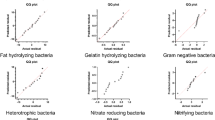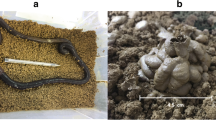Abstract
Laboratory experiments were carried out to investigate the fate of bacteria during and after passage through the intestinal tract of detritivore earthworms. Earthworms (Lumbricus spp.) were fed with cattle dung inoculated 7 days previously with one of five different Gram-negative bacteria. Bacterial concentrations were determined 2 days later in dung and soil, and in gut material from different parts of the earthworm intestinal tract. A high percentage (28–82%) of the total bacteria (epifluorescence direct counts) in the earthworm gut content was culturable. The concentration of total heterotrophic aerobic bacteria did not vary significantly among the five different bacterial additions and the non-inoculated control. In earthworm casts the number of total heterotrophs per gram dry matter (2.1×109) was higher than in soil (1.7×108), but lower than in the dung (1.5×1010). The test-bacteria, however, showed different survival patterns along the earthworm intestinal tract. The concentrations of Escherichia coli BJ 18 and Pseudomonas putida MM 1 and MM 11 in earthworm casts were lower than in the ingested dung, while concentrations of Enterobacter cloacae A 107 and Aeromonas hydrophila DMU 115 in dung and casts were similar. Ent. cloacae, and to aminor extent E. coli, were reduced in numbers by several orders of magnitude in the pharynx and/or crop. In the hind gut, however, the concentration of Ent. cloacae had increased to the same level as in the ingested dung, while the concentration of E. coli remained low. Our observations indicate that the bacterial flora of ingested food materials changes qualitatively and quantitatively during gut transit.
Similar content being viewed by others
References
Anderson RS (1988) Bacteriostatic factor(s) in the coelomic fluid of Lumbricus terrestris. Dev Comp Immunol 12:189–194
Brown BA, Mitchell MJ (1981) Role of the earthworm, Eisenia foetida, in affecting survival of Salmonella enteritidis ser. typhimurium. Pedobiologia 22:434–438
Brüsewith G (1959) Untersuchungen über den Einfluss des Regenwurms auf Zahl und Leistungen von Mikroorganismen im Boden. Arch Mikrobiol 33:52–82
Daniel O, Anderson JM (1992) Microbial biomass and activity in contrasting soil materials after passage through the gut of the earthworm Lumbricus rubellus Hoffmeister. Soil Biol Biochem 24:465–470
Dash MC, Mishra PC, Behera N (1979) Fungal feeding by a tropical earthworm. Trop Ecol 20:9–12
Day GM (1950) Influence of earthworms on soil microorganisms. Soil Sci 69:175–184
Domsch KH, Banse H-J (1972) Mykologische Untersuchungen an Regenwurmexkrementen. Soil Biol Biochem 4:31–38
Edwards CA, Fletcher KE (1988) Interactions between earthworms and microorganisms in organic-matter breakdown. Agric Ecosyst Environ 24:235–247
Hendriksen NB (1990) Leaf litter selection by detritivore and geophagous earthworms. Biol Fertil Soils 10:17–21
Hendriksen NB (1991a) Gut load and food-retention time in the earthworms Lumbricus festivus and Lumbricus castaneus. Biol Fertil Soils 11:170–173
Hendriksen NB (1991b) Consumption and utilization of dung by detritivorous and geophagous earthworms in a Danish pasture. Pedobiologia 35:65–70
Hendriksen NB (1993) Effects of detritivore earthworms on dispersal and survival of the bacterium Aeromonas hydrophila. Acta Zool Fenn (in press)
Hobbie JE, Daley J, Jasper S (1977) Use of nucleopore filters for counting bacteria by fluorescence microscopy. Appl Environ Microbiol 33:1225–1228
Lassègeus M, Roch P, Valembois P (1989) Antibacterial activity of Eisenia fetida andrei coelomic fluid: Evidence, induction, and animal protection. J Invertebr Pathol 53:1–6
Lee KE (1985) Earthworms. Academic Press, Sydney
Maniatis T, Fritsch EF, Sambrook J (1982) Molecular cloning. A laboratory manual. Cold Spring Harbor Laboratory, Cold Spring Harbor, New York
Parle JN (1963) Micro-organisms in the intestines of earthworms. J Gen Microbiol 31:1–11
Pedersen JC (1992a) Natamycin as a fungicide in agar media. Appl Environ Microbiol 58:1064–1066
Pedersen JC (1992b) Survival of Enterobacter cloacae: Field validation of a soil/plant microcosm. Microb Releases 1:87–93
Pedersen JC, Leser TD (1992) Survival of Enterobacter cloacae on leaves and in soil detected by immunofluorescence microscopy in comparison with selective plating. Microb Releases 1:95–102
Pochon J (1954) Manuel technique d'analyse microbiologique du sol. Masson et Cie, Paris
Ponomareva SI (1953) The influence of the activity of earthworms on the creation of a stable structure in a sod-podzolized soil. Tr Pochv Inst Dokuchaeva 41:304–378
Reddell P, Spain AV (1991) Earthworms as vectors of viable propagules of mycorrhizal fungi. Soil Biol Biochem 23:767–774
Satchell JE (1967) Lumbricidae. In: Burges A, Raw F (ed) Soil biology. Academic Press, London, pp 259–322
Satchell JE (1983) Earthworm microbiology. In: Satchell JE (ed) Earthworm ecology. From Darwin to vermiculture. Chapman and Hall, Cambridge, pp 351–364
Scheu S (1987) Microbial activity and nutrient dynamics in earthworm casts (Lumbricidae). Biol Fertil Soils 5:230–234
Stöckli A (1928) Studien über den Einfluss der Regenwürmer auf die Beschaffenheit des Bodens. Landwirtsch Jahrb Schweiz 42:1–121
Tučková L, Rejnek J, Šima P, Ondřejová R (1986) Lytic activities in coelomic fluid of Eisenia foetida and Lumbricus terrestris. Dev Comp Immunol 10:181–189
Valembois P, Seymour J, Roch P (1991) Evidence and cellular localization of an oxidative activity in the coelomic fluid of the earthworm Eisenia fetida andrei. J Invertebr Pathol 57:177–183
Went JC (1963) Influence of earthworms on the number of bacteria in the soil. In: Doeksen J, van der Drift J (ed) Soil organisms. North-Holland, Amsterdam, pp 260–265
Author information
Authors and Affiliations
Rights and permissions
About this article
Cite this article
Pedersen, J.C., Hendriksen, N.B. Effect of passage through the intestinal tract of detritivore earthworms (Lumbricus spp.) on the number of selected Gram-negative and total bacteria. Biol Fertil Soils 16, 227–232 (1993). https://doi.org/10.1007/BF00361413
Received:
Issue Date:
DOI: https://doi.org/10.1007/BF00361413




